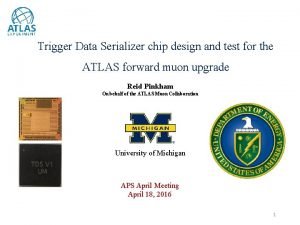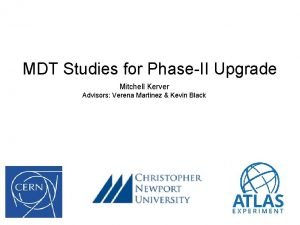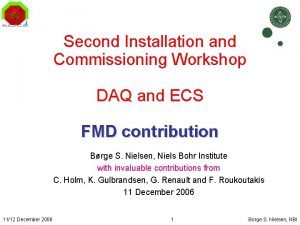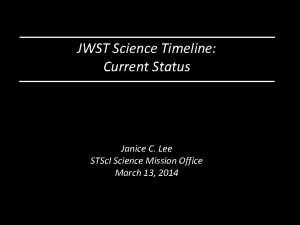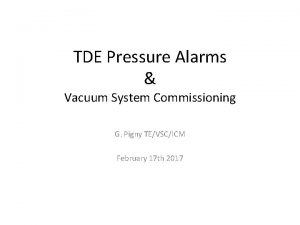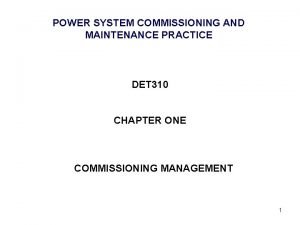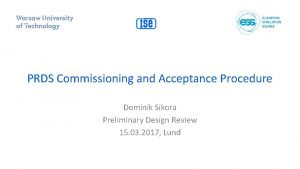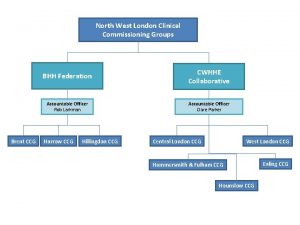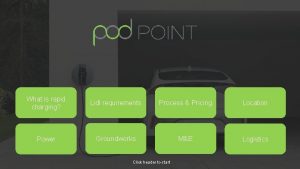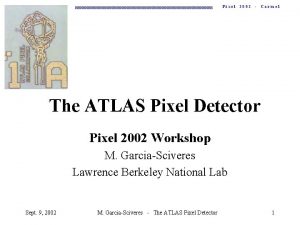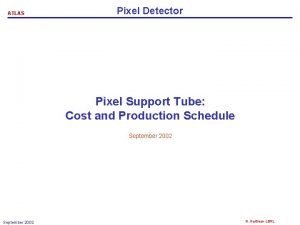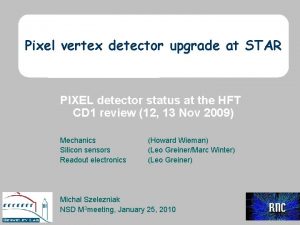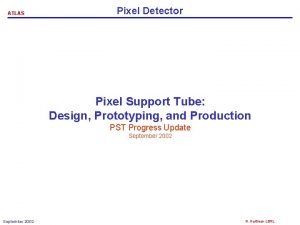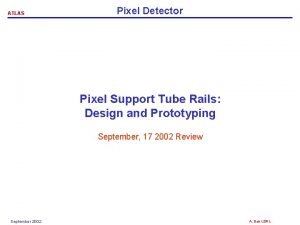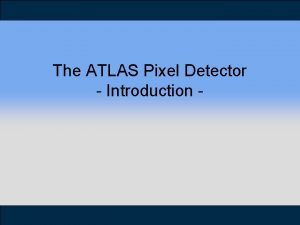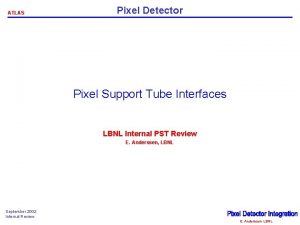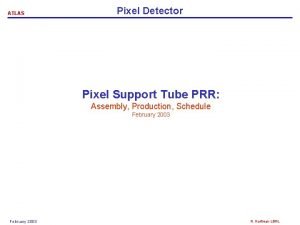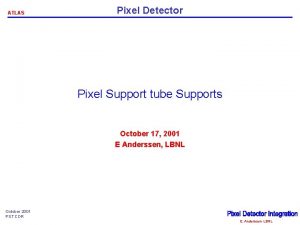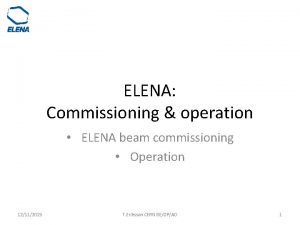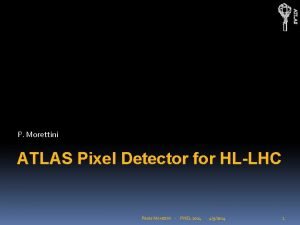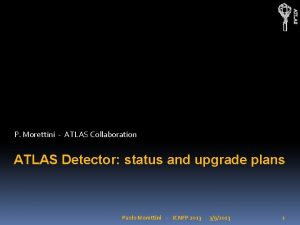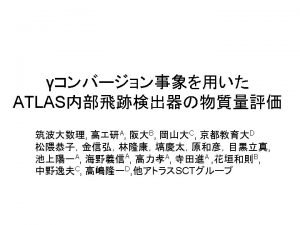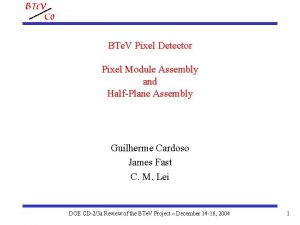Commissioning and Operation of the ATLAS Pixel Detector




















- Slides: 20

Commissioning and Operation of the ATLAS Pixel Detector Joshua Moss, Ohio State University on behalf of the ATLAS Collaboration Pixel 2010 Grindelwald, Switzerland 6 September 2010

Outline Introduction The LHC and the ATLAS experiment at CERN The ATLAS Pixel Detector commissioning and operation Current status Operational safety Online Monitoring Beam backgrounds Conclusions J. Moss - 2 Commissioning and operation of the ATLAS pixel detector 6 September 2010

The LHC at CERN A proton-proton collider located on the France-Switzerland border outside of Geneva 27 km long ring previously housing LEP 1232 superconducting dipole magnets 7 Te. V nominal beam energy 1034 cm-2 s-1 nominal luminosity 2808 proton bunches per beam 25 ns bunch spacing (40 Mhz) Operating since Fall 2009 First 900 Ge. V collisions – Nov 2009 Began operations at 3. 5 Te. V – Feb 2010 Current operating parameters: beam energy= 3. 5 Te. V luminosity~1 x 1031 cm-2 s-1 J. Moss - 3 Commissioning and operation of the ATLAS pixel detector 6 September 2010

The ATLAS Experiment Multi-purpose detector designed to: • Investigate the Te. V scale • Search for the Higgs boson • Search beyond the standard model • Supersymmetry • Mini-black holes • Leptoquarks • Extradimensions • Make precision measurements of SM 25 m 45 m J. Moss - 4 Commissioning and operation of the ATLAS pixel detector 6 September 2010

ATLAS Pixel Detector The Pixel Detector: – 1442 mm long – 430 mm in diameter – 1. 7 m 2 active area of silicon • 3 barrel layers – 1456 modules • 3 disks per endcap – 288 modules • ~80 million channels J. Moss - 5 • Operates in 2 T solenoid magnetic field • 3 precision measurements points covering | | <2. 5 • Design R resolution ~10 m • Design resolution ~115 m • Power consumption ~15 k. W Commissioning and operation of the ATLAS pixel detector 6 September 2010

ATLAS Pixel Modules Sensor: 250 m thick silicon sensor n-doped bulk, n+ pixels & p+ backplane Pixels: 50 m (R ) x 400 m ( ) nominal Long, ganged, interganged pixels between chips Amplitude of the signal measured in the form of a Time-over-Threshold (To. T) Pixel by pixel threshold tuned to ~3500 e Readout: 16 FEs bump bonded per module: DSM 0. 25 m CMOS Radiation hard up to NIEL-1015 neq/cm 2 fluence MCC – module control chip Routes command configuration data to individual FEs Aggregates data from chips for transmission to the off-detector readout drivers (RODs) J. Moss - 6 Commissioning and operation of the ATLAS pixel detector 6 September 2010

Services - Cooling Evaporative cooling system used to maintain a module temperature of less than - 10 o. C Coolant – C 3 F 8, with T = -25 o. C Cools both the Pixel Detector and the Semi-Conductor Tracker (SCT) 88 individual loops for the Pixel Detector Continuous operation for all of 2010 with very high efficiency >95% Leak rate is currently 1. 8 kg/day for both Pixel Detector and the SCT J. Moss - 7 Commissioning and operation of the ATLAS pixel detector 6 September 2010

Readout Links 8 -way VCSEL arrays Information transferred to and from the detector over an 80 m optical link 1 downlink per module, 1 uplink for L 2, L 1 and Disk, 2 uplinks for B-layer Trigger and configuration sent at 40 Mbit/s from the readout driver’s Back of Crate (BOC) card B-layer – 160 Mbit/s (2 x 80 1, Disks 80 Mbit/s on location Layer 2 – 40 Data is transferred from the. Mbit/s) detector at Layer different rates– depending Mbit/s Each VCSEL array (both on-detector and off-detector) services 6 or 7 modules J. Moss - 8 Commissioning and operation of the ATLAS pixel detector 6 September 2010

Timeline 2006 – Detector construction Installatio n May 2007 – Installation in ATLAS Sept 2008 – First cosmic events Oct 2008 – LHC incident Nov 2009 – First beam 450 Ge. V Dec 2009 – 900 Ge. V collisions , Stable beams! Calibratio n March 2010 – 7 Te. V Collisions, Stable beams! September 2010 – 3. 6 pb-1 900 Ge. V Collision s J. Moss - 9 7 Te. V Collision s Commissioning and operation of the ATLAS pixel detector Cosmic s 6 September 2010

Current Status of the Pixel Detector 1697 of 1744 modules are active in data-taking 47 module disabled (2. 7%) 27860 of 27904 front end chips are enabled 44 FEs disabled (0. 16%) 271 of 272 optoboards are included in operations 6 or 7 modules per optoboard J. Moss - 10 Commissioning and operation of the ATLAS pixel detector 6 September 2010

Inefficiencies on Modules Hit efficiency of Disk modules in Endcap A Occupancy plots for 3 modules with smallest efficiency J. Moss - 11 Commissioning and operation of the ATLAS pixel detector 6 September 2010

Readout Window For each trigger received, the module can read out up to 16 consecutive 25 ns buckets (Bunch Crossings – BC) Timewalk effect due to the risetime of the preamplifier can shift low amplitude (To. T) hits into the next time bucket Goal is to eventually run with 1 BC readout To compensate for timewalk, low charge hits can be written twice – first with original timestamp, then with the previous BC timestamp Comics in 2008 – 8 BC readout First collisions 2009 – 5 BC readout May 2010 – 4 BC readout July 2010 – 3 BC readout August 2010 – 2 BC readout J. Moss - 12 Commissioning and operation of the ATLAS pixel detector 6 September 2010

Pixel Operations Detector safety: Until “STABLE BEAMS” are declared by the LHC, the HV for the modules is off. This can be bypassed for calibration periods. Warm start procedure: Module configuration is performed at the start of a run Without HV, modules are noisy and can block the DAQ To reduce noise, FE preamplifiers are killed when HV is off When LHC declares STABLE BEAMS: Checks of beam conditions and collimator positions are made HV is ramped up Preamplifiers are enabled Collimators and Magnets near ATLAS interaction point J. Moss - 13 Commissioning and operation of the ATLAS pixel detector 6 September 2010

Beam Conditions Monitor Two 4 -module stations symmetrically positioned at z=± 1840 mm around IP Radially positioned at r=55 mm Mounted at 45 o w. r. t. the beam pipe, giving 41% increased signal Provides protection against single turn and multi-turn losses in the LHC TRT Endcap SCT Pixel SCT Endca BCM p BCM ATL AS Inne r De tect ors Modules consist of two 10 mm x 10 mm p. CVD diamonds, 500 m thick Nominally biased at 1000 V Signal is split to provide 2 thresholds per module: high and low gain J. Moss - 14 Commissioning and operation of the ATLAS pixel detector 6 September 2010

Beam Conditions 390 ps timing resolution allows for time of flight discrimination between background events and collision events Useful in determining the beam conditions prior to switching on the Pixel Detector Can protect ATLAS from dangerous conditions by triggering beam aborts J. Moss - 15 Commissioning and operation of the ATLAS pixel detector 6 September 2010

Pixel Operations – Monitoring ONLINE detail of information acquisition rate OFFLINE Information with almost physics measurement quality: • efficiency • alignment quality • resonances Track association efficiency • Occupancy + Disabled • Readout errors modules • To. T distribution J. Moss - 16 + Hit and cluster properties + Track reconstruction Courtesy of A. Andreazza, INFN & Universita di Milano Commissioning and operation of the ATLAS pixel detector 6 September 2010

Noise Masks and Module Occupancy Dedicated runs are taken with a random trigger and no beam to measure the noise occupancy Noisy pixels are masked online at the level of 10 -5 Individual pixels are disabled not read out Online noise is reduced below 10 -7 Offline noise mask applied for data reconstruction Created run by run Applied during the “prompt calibration loop” ~80 k pixels disabled for the online noise mask Out of 80 M total channels, ~ 0. 01% Typical module occupancies B 3 : x 10 -5 layer J. Moss - 17 10 -5 Layer 1 1 x Layer 2 0. 8 x 10 -5 7 Te. V collisions Commissioning and operation of the ATLAS pixel detector -5 6 September 2010

Beam Background Studies Events with large numbers of hits per module can cause blocking of the DAQ due to the long readout time from the event size. High occupancy events can originate from beam gas and beam halo events which impact the Pixel Detector parallel to the beam pipe (z-direction) Studying the colliding (paired) and the non-colliding (unpaired) bunches, the characteristics of the clusters from beam backgrounds can be investigated. J. Moss - 18 Commissioning and operation of the ATLAS pixel detector 6 September 2010

Data-Taking Efficiency Integrated Luminosity • Weekly improvements in peak and integrated luminosity delivered by the LHC • Losses in Pixel Detector data-taking efficiency dominated by the “warm start” procedure Peak Luminosity Pixel efficiency for data-taking is 97. 7% J. Moss - 19 Commissioning and operation of the ATLAS pixel detector 6 September 2010

Conclusions The ATLAS Pixel Detector is performing very well 97. 3% of pixel modules are included in data-taking The data-taking efficiency is currently at 97. 7% Calibration procedures and data-taking preparations are now routine (see talk by M. Keil) Offline alignment and analysis are producing good results and are continually being improved (see talk by L. Dell’Asta) Our understanding of the detector and operational procedures continue to improve with experience We are looking forward to increased luminosity from the LHC this fall and on into 2011! J. Moss - 20 Commissioning and operation of the ATLAS pixel detector 6 September 2010
 Atlas detector
Atlas detector Atlas detector
Atlas detector Integrated commissioning and progress system
Integrated commissioning and progress system Commissioning cycle
Commissioning cycle Aecp fy 2023
Aecp fy 2023 Steps
Steps Ecs commissioning
Ecs commissioning Fortis commissioning sheet
Fortis commissioning sheet Jwst time line
Jwst time line Human and physical features
Human and physical features Commissioning cycle
Commissioning cycle Value based commissioning
Value based commissioning Vacuum systems commissioning
Vacuum systems commissioning Power system commissioning
Power system commissioning Central commissioning facility research management system
Central commissioning facility research management system Dominik sikora
Dominik sikora Brent clinical commissioning group
Brent clinical commissioning group Commissioning
Commissioning Aabc commissioning group
Aabc commissioning group Lidl ev charging
Lidl ev charging Croydon clinical commissioning group
Croydon clinical commissioning group
